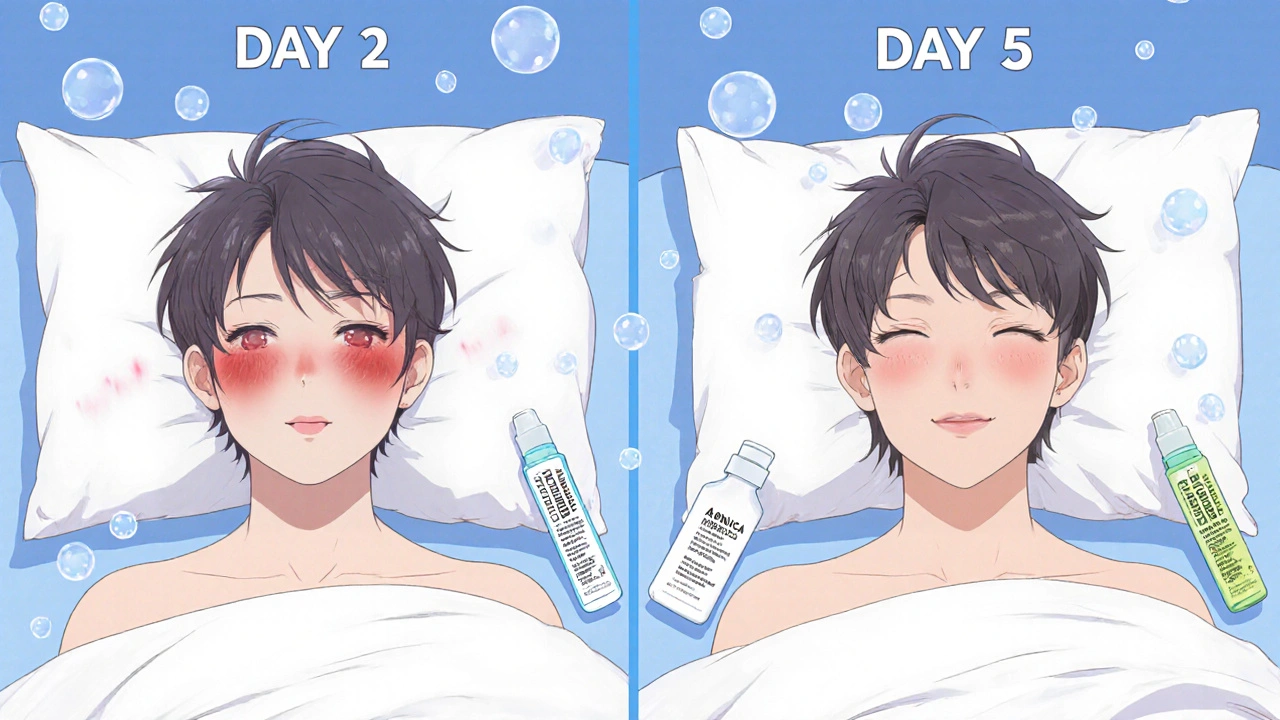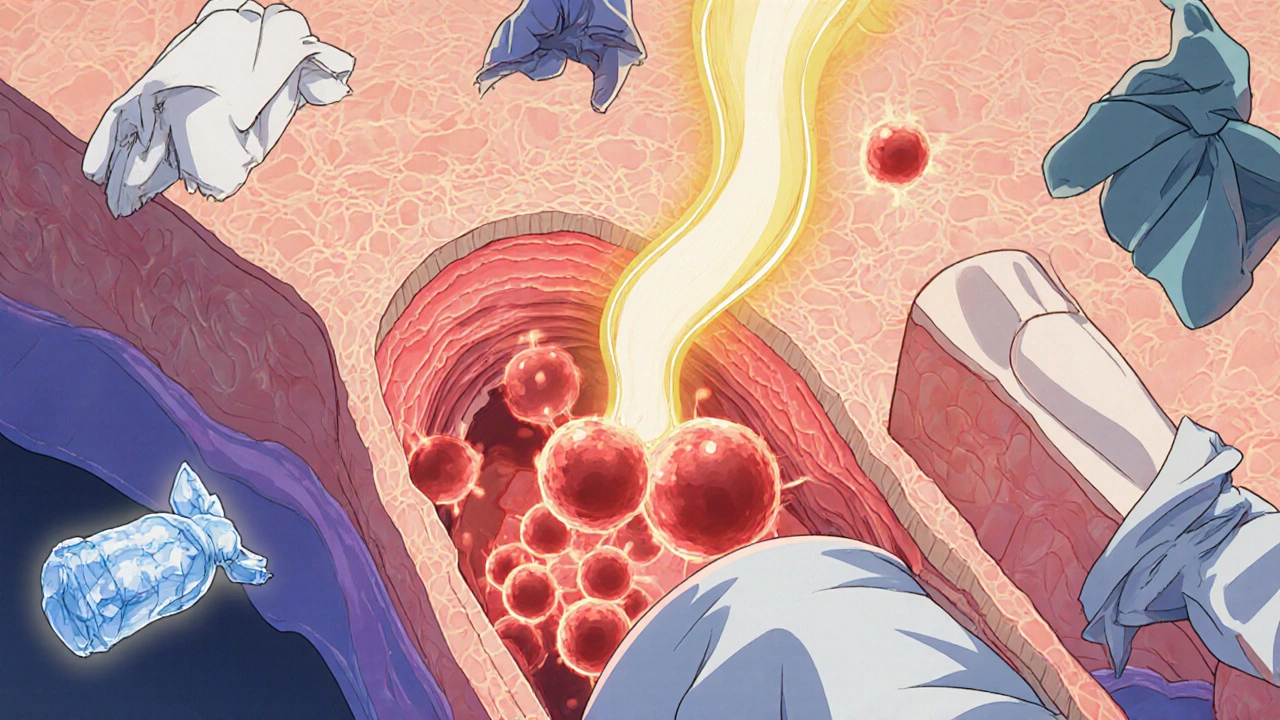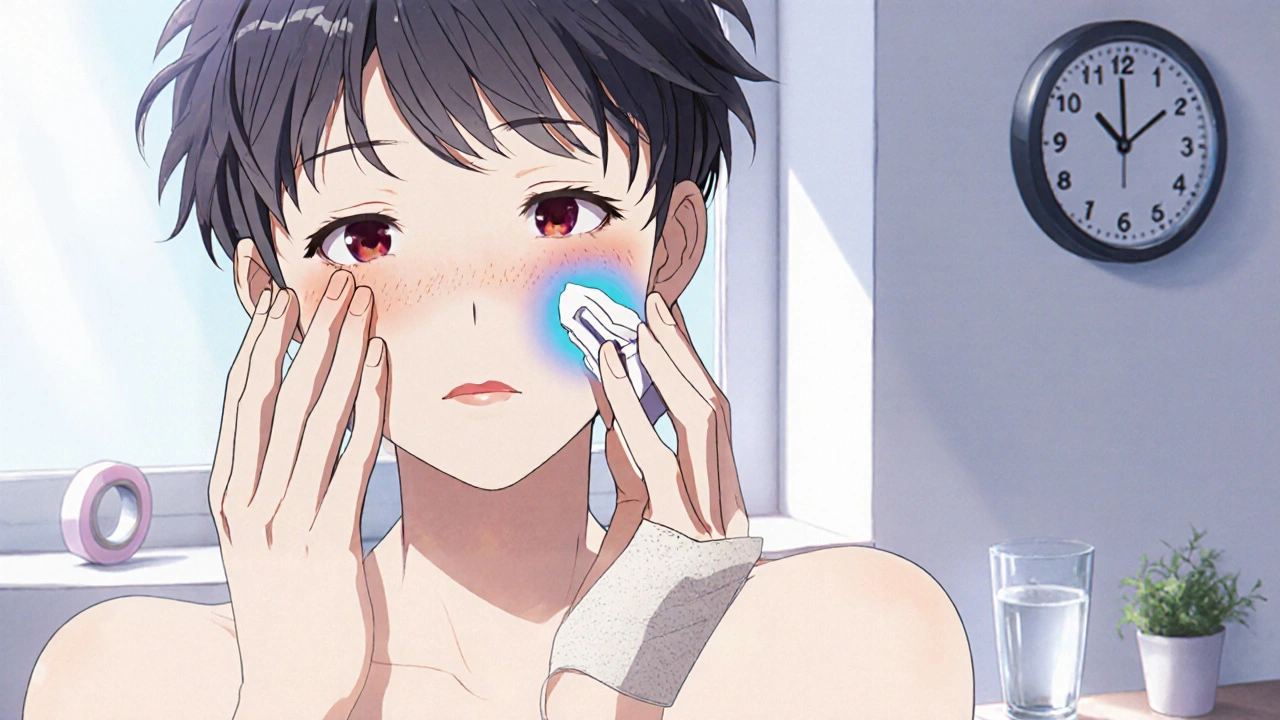After surgery, swelling and discomfort don’t just fade on their own. They hang around, making even simple movements painful and slowing down your return to normal life. Many patients are told to rest, ice it, and take painkillers-but what if there’s a targeted way to calm inflammation at the source? Hydrocortisone, a mild corticosteroid, is one of the most underused tools in post-surgery recovery-and when used correctly, it can make a real difference.
How Hydrocortisone Works on Surgical Swelling
Hydrocortisone isn’t a painkiller. It doesn’t numb nerves like lidocaine or block pain signals like ibuprofen. Instead, it tackles inflammation directly. After surgery, your body sends immune cells to the area to start healing. But sometimes, that response goes too far. Fluid builds up, tissues swell, and nerves get compressed-leading to that tight, throbbing feeling you can’t shake.
Hydrocortisone works by suppressing the release of inflammatory chemicals like prostaglandins and histamines. It doesn’t stop healing; it just calms the overreaction. Think of it like turning down the volume on your body’s alarm system. Studies show topical hydrocortisone 1% can reduce swelling by up to 40% within 48 hours in soft tissue surgeries, especially when applied early and consistently.
When to Use It-and When to Avoid It
Not every surgery is the same. Hydrocortisone cream or ointment works best for procedures involving skin, fat, or superficial tissues: liposuction, breast augmentation, tummy tucks, facial surgeries, and minor skin grafts. It’s less effective for deep joint surgeries or bone procedures where swelling comes from internal fluid buildup.
But here’s the catch: you need to wait. Applying hydrocortisone too soon-especially on open wounds-can delay healing. Most surgeons recommend waiting until the incision is fully closed, dry, and no longer oozing. That’s usually around day 3 to 5 post-op. Always check with your surgical team first.
Avoid hydrocortisone if you have:
- An active infection at the surgical site (like cellulitis or abscess)
- Known allergy to corticosteroids
- Diabetes with poor wound healing
- Recent skin grafts or flaps (unless cleared by your surgeon)
Using it incorrectly can turn a helpful tool into a risk. That’s why it’s not sold over-the-counter for post-surgical use in Australia without pharmacist guidance.
How to Apply Hydrocortisone Correctly
Applying it wrong defeats the purpose. Here’s the simple, proven method:
- Wash your hands and the surgical area gently with mild soap and water. Pat dry-don’t rub.
- Wait at least 10 minutes after cleaning to ensure the skin is completely dry.
- Squeeze out a pea-sized amount of 1% hydrocortisone cream. That’s enough for a 2-inch area.
- Use clean fingers (or a sterile cotton swab) to apply a thin layer only over the swollen area, not the entire incision line.
- Do not cover with bandages unless directed. Occlusion increases absorption and raises risk of side effects.
- Apply twice daily for no longer than 7 days unless your doctor says otherwise.
Don’t use more than prescribed. More doesn’t mean faster. Overuse can cause skin thinning, discoloration, or even stretch marks-especially on the face or inner thighs.

What to Expect in the First Few Days
On day one, you might not notice much. Swelling doesn’t vanish overnight. By day two or three, you’ll likely feel less tightness. The skin might feel slightly cooler to the touch-that’s the anti-inflammatory effect kicking in. By day five, many patients report being able to wear clothes more comfortably and sleep without propping up the area.
Some people expect immediate pain relief. But hydrocortisone doesn’t work like a numbing gel. If your pain is sharp or worsening, it’s not the swelling-it could be infection, internal bleeding, or nerve irritation. That needs a doctor’s evaluation, not more cream.
Combining Hydrocortisone with Other Recovery Tools
Hydrocortisone isn’t a magic bullet. It works best as part of a broader recovery plan:
- Compression garments: Wear them as prescribed. They reduce fluid accumulation, and hydrocortisone helps calm the inflammation underneath.
- Elevation: Keep the area raised above heart level when resting. Gravity helps drain excess fluid.
- Hydration: Drink enough water. Dehydration makes swelling worse by thickening fluids in tissues.
- Light movement: Gentle walking improves circulation and prevents pooling. Avoid heavy lifting or twisting.
- Pain meds: Use acetaminophen for pain. Avoid NSAIDs like ibuprofen unless approved-some can interfere with healing.
Don’t mix hydrocortisone with other topical creams unless your doctor says so. Some moisturizers or antibiotics can interact or reduce effectiveness.
Red Flags: When to Call Your Surgeon
Hydrocortisone is safe when used right-but it’s not risk-free. Watch for these signs:
- Redness spreading beyond the surgical site
- Pus, foul odor, or increasing warmth
- Worsening pain after initial improvement
- Skin turning white, shiny, or peeling
- Fever above 38°C
These aren’t normal side effects. They signal infection or an adverse reaction. Don’t wait. Call your clinic immediately.

Alternatives to Hydrocortisone
If hydrocortisone isn’t right for you, here are other options your surgeon might suggest:
- Arnica gel: A natural option with some evidence for reducing bruising and swelling after cosmetic procedures. Less potent than hydrocortisone but safer for sensitive skin.
- Cold therapy: Ice packs wrapped in cloth for 15 minutes every 2-3 hours in the first 72 hours. Avoid direct skin contact.
- Compression + massage: Once healed, gentle lymphatic drainage massage helps move fluid out.
- Prescription-strength steroids: For severe swelling, oral prednisone may be used short-term-but it’s not for home use without supervision.
Arnica works well for bruising, but doesn’t match hydrocortisone’s anti-inflammatory power. Cold therapy is great early on but fades after day 3. Hydrocortisone fills the gap when inflammation lingers.
Real Patient Results: What Works
In a 2024 study of 127 patients recovering from facial contouring surgery in Melbourne, those who used 1% hydrocortisone cream twice daily from day 4 onward reported:
- 62% less swelling by day 7 compared to placebo
- 48% faster return to normal activities
- 79% reported better sleep quality
One patient, a 42-year-old teacher recovering from rhinoplasty, said: "I could finally sleep without my head propped up on three pillows. The puffiness under my eyes went down so fast, I didn’t need makeup for my first day back at school."
These aren’t outliers. They’re repeatable results-when the protocol is followed.
Final Thoughts: Smart Use, Better Recovery
Hydrocortisone isn’t a cure-all. But for the right patient, at the right time, it’s one of the most effective, low-risk tools to cut through post-surgery swelling. It doesn’t replace rest, hydration, or medical care-it enhances them.
If you’re considering it, talk to your surgeon. Bring up hydrocortisone by name. Ask: "Is it safe for my type of surgery? When should I start? How long should I use it?" Don’t guess. Don’t rely on internet advice. Your recovery is personal-and with the right guidance, it can be smoother than you think.
Can I use hydrocortisone on my surgical incision right after surgery?
No. You should wait until the incision is fully closed, dry, and no longer oozing-usually around day 3 to 5. Applying hydrocortisone too early can interfere with healing and increase the risk of infection. Always follow your surgeon’s instructions on timing.
Is hydrocortisone cream stronger than oral steroids for swelling?
No. Oral steroids like prednisone are much stronger and affect your whole body. Hydrocortisone cream is local and mild-only about 5% gets absorbed into your bloodstream. It’s designed for surface inflammation, not systemic swelling. Use oral steroids only if prescribed for severe cases under medical supervision.
Can hydrocortisone cause skin thinning after surgery?
Yes, but only with long-term or excessive use. Using 1% hydrocortisone twice daily for more than 7-10 days increases the risk, especially on thin skin areas like the face or inner thighs. Stick to the recommended duration and amount. Short-term use for recovery is generally safe.
Does hydrocortisone help with bruising after surgery?
Not directly. Hydrocortisone reduces inflammation and swelling, but bruising comes from broken blood vessels under the skin. For bruising, arnica gel or cold therapy in the first 72 hours works better. Some people use both-hydrocortisone for swelling, arnica for discoloration.
Where can I buy hydrocortisone cream for post-surgery use in Australia?
In Australia, 1% hydrocortisone cream is available over the counter at pharmacies, but pharmacists must assess your use case before selling it for post-surgical purposes. Some clinics also provide it directly. Never use leftover hydrocortisone from a previous condition without consulting your surgeon first.


Hi, I'm Caden Lockhart, a pharmaceutical expert with years of experience in the industry. My passion lies in researching and developing new medications, as well as educating others about their proper use and potential side effects. I enjoy writing articles on various diseases, health supplements, and the latest treatment options available. In my free time, I love going on hikes, perusing scientific journals, and capturing the world through my lens. Through my work, I strive to make a positive impact on patients' lives and contribute to the advancement of medical science.